Feeding baby sloth
Baby Sloths: Everything you always wanted to know
A baby sloth is fully reliant on it’s mother to teach it how to survive in the canopy of the rainforest. They are fragile yet fascinating little creatures, and here you can learn everything you ever wanted to know about baby sloths!
Giving Birth to a Baby Sloth
A two-fingered female sloth will give birth to a single baby after a gestation period of 11.5 months, while a three-fingered sloth is thought to give birth after approximately six months. Biologists have never had the opportunity to follow a three-fingered sloth all the way from conception to birth, and so this gestation period is still only an approximation.
When it’s time to give birth, the mother will usually descend to the lower canopy branches and give birth while hanging upside down. In this position, if the baby falls to the ground, it won’t fall far, and the mother can climb down to retrieve her young.
A three-fingered sloth after giving birth, Costa Rica / Photo: Agustín Murillo
The afterbirth usually falls to the forest floor and female sloths have been known to descend to the ground to consume it – it is very common for animals in the wild to ingest the afterbirth, even herbivores like sloths, probably for a nutritional boost or to avoid attracting the attention of predators.
Occasionally, sloths have been known to give birth to twins, but there is only enough room on the female’s chest for one baby and the sloth’s very slow metabolism only provides enough resources for one, so the weakest twin will usually be rejected.
Baby Sloth Features
A baby sloth is born ready to face the world with eyes open, sharp claws, and fully formed teeth.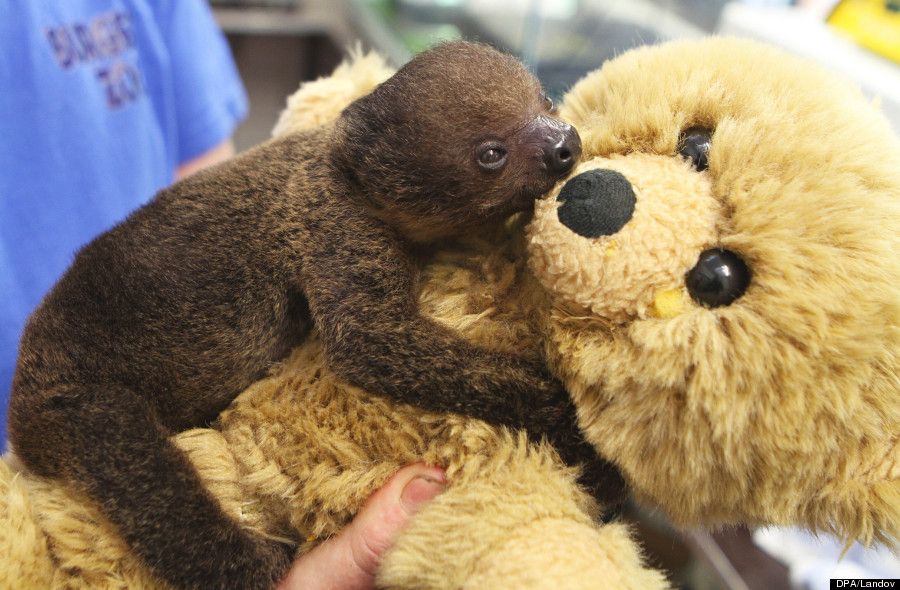 It will instinctively cling to it’s mother’s fur immediately after birth and crawl up towards the safety of her chest where she begins the process of cleaning the young with her mouth.
It will instinctively cling to it’s mother’s fur immediately after birth and crawl up towards the safety of her chest where she begins the process of cleaning the young with her mouth.
Three-fingered sloth (Bradypus variegatus) newborn baby (less than 1 week old) clinging to mother. /Photo: Suzi Eszterhas.
Read More: The true stories behind these famous baby sloth photos
The weight and size of baby sloths differs between the six extant species. Three-fingered sloths are smaller than two-fingered sloths. A newborn baby sloth typically weighs between 300 – 500 grams, with three-fingered babies often weighing less than two-fingered babies.
This three-fingered sloth is a 2 day old orphaned baby/ Aviarios Sloth Sanctuary, Costa Rica / Photo: Suzi Eszterhas
How much do baby sloths sleep?
Despite the common myth that a sloth will sleep for 20 hours per day, adult sloths in the wild actually only sleep for an average of 8 to 10 hours per day.
Currently, no research has been conducted into the sleeping habits of wild baby sloths, however, if we extrapolate data from other mammals, we can hypothesize that baby sloths will sleep for a larger portion of the day than adults as they do not have to be on the constant lookout for predators or forage for food – their mom’s do that for them!
Adult and baby sloths in human facilities (zoos/rescue centers) sleep for an average of 15 hours per day.
Cute baby two-fingered sloth yawning after a hard day of… sleeping.
Raising a baby sloth
Male sloths, as with most mammals, don’t care for their young. The female sloth will spend up to 12 months of her life raising her baby alone.
The baby clings on the mother’s chest for approximately six months, regularly suckling small amounts of milk throughout the day.
Pale-throated sloth (Bradypus tridactylus) mother and three-month-old baby / Sloth Island, Guyana / Photo: Suzi Eszterhas
Sloth mothers don’t store large amounts of milk like most other mammals – carrying a heavy supply of milk around is expensive in terms of energy. Because baby sloths are always clinging onto their mother’s chest, females save energy by slowly producing small amounts of milk throughout the day instead.
Because baby sloths are always clinging onto their mother’s chest, females save energy by slowly producing small amounts of milk throughout the day instead.
As well as drinking milk, baby sloths will begin to sample leaves from around their mother’s mouth from as early as 1 week old – this is how the baby learns which leaves are good to eat!
Exploring with mom
While young baby sloths usually spend the majority of their time on their mother’s chest, they will occasionally cling onto the fur on her back. This usually happens while she is crawling across the ground, however, as the baby grows it will begin to move around more, and will often take this opportunity to explore what is going on around mom.
At first, this will be reaching out to grab different leaves and branches with two or three limbs, still maintaining a connection with mom, but as the baby slowly gains confidence (and becomes too heavy for mom to carry), they will spend an increasing amount of time next to mom, rather than clinging to her.
This is Luna and Sol (Moon and Sun) and they are part of our Urban Sloth Project. On the ground, Sol will climb onto his mom’s back, but he is usually hidden from sight when they are up in the trees as he will curl up into Luna’s chest. Recently, we have been seeing more of Sol as he grows more adventurous.
Learning to poop
Once a week, the mother will climb down to defecate at the base of a tree. The baby sloth will start pooping following the patterns of the mother.
The ‘poop dance’ is something that all sloths do immediately before and after they defecate, and it involves wiggling around at the base of the tree. This dance helps them to clear a space in the leaf litter for them to defecate into, and then cover up the evidence of their weekly journey to the ground afterward. Three-fingered sloths are particularly good at this as they have a short stubby tail that helps to dig a deeper hole!
Read more: Why do sloths really poop on the ground?
Falling from the trees
Sometimes a baby sloth will fall from its mother’s chest to the ground where it is very vulnerable to predators.
Sloths are built to survive falls of up to 100ft to the forest floor – however, they are not adapted to fall onto concrete or roofs. As more of their jungle home disappears, sloths are less likely to survive falls.
When a baby sloth falls and becomes separated from mom, they will cry to alert their mother to where they are. Mom will climb down from the canopy to retrieve her baby, but as sloths have a top speed of 2mph, this journey will take a lot of time and energy.
The ground is not a safe place for a baby sloth.

Reuniting with mom – with the help of humans!
In urban areas, well-meaning members of the public may assume that a baby sloth on the ground is in trouble, and will take them to a rescue center before mom has the chance to reach her baby. Rescue centers have developed a technique to reunite mothers with their babies in these situations, by recording the baby’s cry and playing the recording on a loudspeaker where the baby was discovered.
Baby sloth cries are loud, but the jungle is louder (especially in urban areas where cars and construction noise pollute the air). If mom is still around, she will spring into action and slowly head towards the cry coming from the loudspeaker. The lost baby can be placed on the tree trunk once mom is close enough, and mom can scoop her baby up and return to the canopy.
However, if a baby falls from mom too many times, mom may stop retrieving them. This is because a mother will perceive something wrong with a baby who cannot hold onto her fur consistently, and with survival being the name of the game in the wild, a mother who has an indication that her baby is not completely healthy is likely to reject them.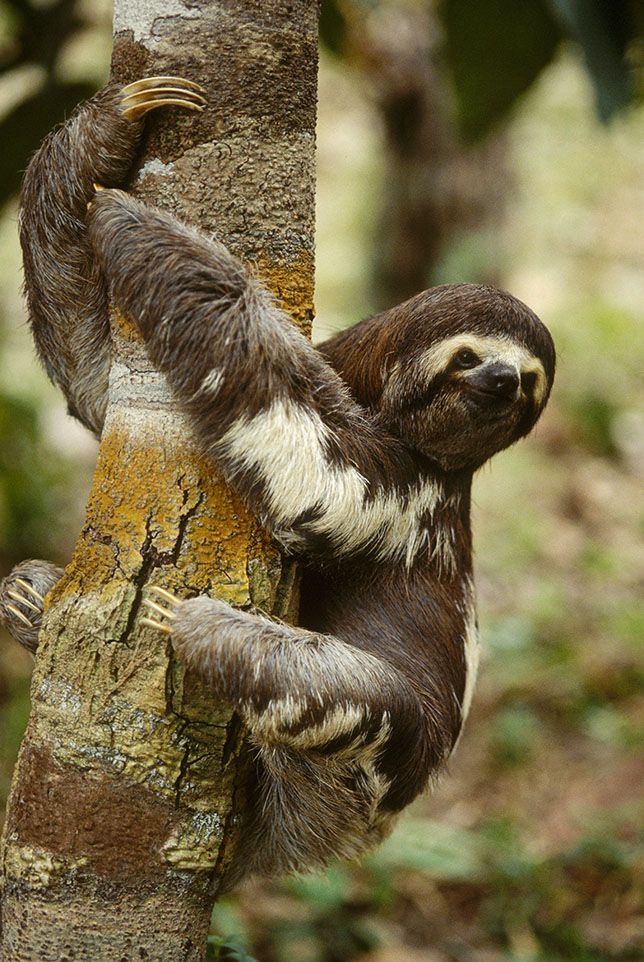
There have been reports from rescue centers that mother sloths have come down from the canopy to their babies, only to sniff them and climb back up without the baby, showing the baby sloth has been truly rejected by the mother. In this case, there is a high risk that the baby has congenital abnormalities. Not to mention, climbing up and down from the canopy repeatedly exerts a large amount of energy from a sloth who does not have much to spare!
Rescued baby sloths learning to climb.
What should you do if you find a baby sloth close to the ground? Keep watch until nightfall, unless the baby is in immediate danger from predators. If 12 hours have passed with no sign of the mother, please contact your local rescue center.
Crying Baby Sloth
Sloths are usually silent creatures as their greatest survival techniques are camouflage and stealth. However, baby sloths will call for mom when they are separated, and this creates some of the cutest sounds and noises imaginable.
Three-fingered baby sloths make a high pitch squeak, while two-fingered babies sound like baby goats (they ‘meep’).
Baby Sloth Diet
As a baby sloth grows, it learns what to eat by copying exactly what its mother is eating. At first, the baby will eat the food from around the mother’s mouth. As it gets older, it will begin to reach off of her body to grab leaves for itself while she is feeding. Through this process, the baby sloth will learn essential lessons about which tree species are safe to eat.
Through this process, the baby sloth will learn essential lessons about which tree species are safe to eat.
Three-fingered mother and newborn baby (less than 1 week old) feeding from Cecropia leaves / Photo: Suzi Eszterhas
Although sloths are known to feed from more than 90 different tree species, an individual will rotate among approximately seven to 12 favorite feeding trees – a strategy that prevents them from overeating specific toxins present in the leaves. When babies begin to eat leaves fresh from the trees, rather than mulch from their mom’s mouths which are already partially broken down due to enzymes in her saliva, mom will direct her baby to the youngest, most tender leaves of the tree.
A sloth mother feeding on Cecropia leaves while her baby is watching / Photo: Suzi Esterhas
Not only do these young leaves have lower levels of any potential toxins, but the cellulose cell wall of the plant is less well established in young leaves, making them easier to digest.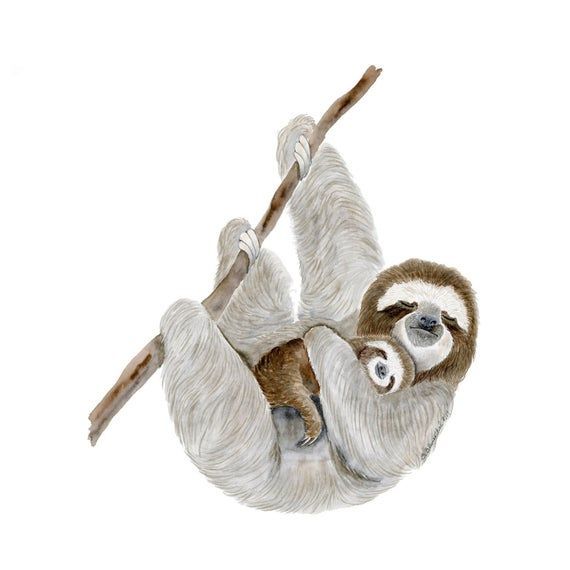
Due to their incredibly slow metabolism and rate of digestion, if sloths were to feed from the same tree species for too long, it is thought that they would intoxicate themselves. Sloths learn this behavior and inherit their feeding tree preferences from their mothers, which may be why releasing hand-reared sloths into the wild can be particularly difficult.
Hibiscus flowers are like candies for baby sloths, and common food in rescue centers and sanctuaries.
Green Offsprings
Baby sloths will look very different from their mothers when they are born. Adult sloths tend to have some algal and fungal growth on their outer fur, whereas babies are born with only the soft, downy undercoat. They develop coarse outer fur at sexual maturity.
Wild sloths begin to develop their green color after approximately 18 months, as algae, fungi, and insects pass from mother to offspring. For this reason, sloths raised in captivity do not develop the famous green coloration, as they are not interacting with any wild sloths who do have flora and fauna growing on their fur.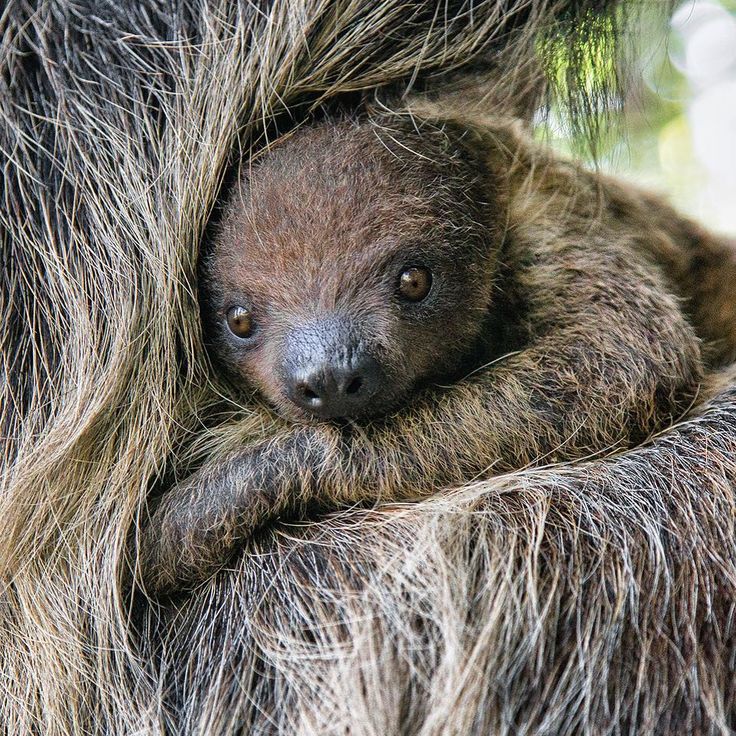
These young sloths raised by humans haven’t yet got algae growing in their fur.
Read More: Sloth hair, algae, fungi, and moths
Becoming Independent
At about six months old, the baby sloth will begin to venture off the mother’s body and spend more time hanging out close by. As independence draws closer, the distance between mother and baby slowly grows.
Eventually, the mother sloth will completely leave her original home range and move to a neighboring patch of forest. This is an unusual method of separation for a mammal, as typically the baby is expected to disperse and establish a territory elsewhere.
Baby pygmy three-fingered sloth (Bradypus pygmaeus) hanging on a tree close to its mother. / Photo: Suzi Eszterhas
Three-fingered sloths weigh 1 – 1.5kg once they reach independence, while two-fingered sloths weigh closer to 2kg.
After separating from its mother, the juvenile sloth becomes solitary and will only choose to interact with others when finding a mate. And now the baby sloth life cycle is completed.
And now the baby sloth life cycle is completed.
A juvenile two-fingered sloth (Choloepus hoffmanni) in the same tree as its mother.
A rare case: three-fingered sloth ‘adopts’ a two-fingered sloth baby
Cross-species adoptions in the wild are exceptional events, and very rare to see. At the end of 2020, we received a highly unusual report of a three-fingered female that adopted a two-fingered baby in Costa Rica.
The reasons behind this behavior are still unknown, and at the moment there are no reports of a similar case. According to the naturalists that were following them on a daily basis to gather data and information, they looked very comfortable together. You can read more about this case here.
Read More: Three-fingered sloth ‘adopts’ a two-fingered sloth baby!
How to make a baby sloth
Sloths reach sexual maturity at approximately two years old. However, when you are a slow mover without much energy to spare, finding a mate can be difficult.
However, when you are a slow mover without much energy to spare, finding a mate can be difficult.
Female three-fingered sloths have found an unexpected solution to this problem – they scream! When she enters estrus, a female will emit high-pitched vocalizations to attract the attention of males.
Two-fingered sloths do not vocalize. Instead, both males and females mark their scent by rubbing their anal glands against tree branches to send messages about their reproductive status.
While sloths will typically only descend from the canopy to relieve themselves once a week, a female sloth will make the long journey down to the forest floor every single day when she is in estrus. Pheromones present in urine and feces are an incredibly important method of communication for all types of sloths and are likely the reason behind their unusual defecation habits.
Pheromones present in urine and feces are an incredibly important method of communication for all types of sloths and are likely the reason behind their unusual defecation habits.
What is the name of a baby sloth?
There are a lot of names for babies of different animal species: calf, kitten, fawn, cub, piglet, duckling, etc… but we don’t yet have a specific name for a baby sloth! Scientists, biologists, and zoologists usually use the generic words ‘offspring’, ‘young’, and ‘baby,’ of course.
The Sloth Sanctuary of Costa Rica suggests the word ‘Slowbie’ to refer to a baby sloth.
A two-fingered sloth and a three-fingered sloths touching noses before kissing each other.
Read More: What do you call a group of sloths?
Baby sloths in captivity
Raising rescued young sloths in the nursery, a rescue center, or zoo is difficult for a variety of reasons.
No one has collected a large enough sample of sloth milk for thorough analysis, as mothers produce milk drop by drop as needed by their baby. This makes it very difficult to know what rescue centers should be feeding orphaned babies!
This makes it very difficult to know what rescue centers should be feeding orphaned babies!
Most have found that a mixture of mineral water, pureed vegetables, powdered goat’s milk, and supplements can provide an alternative for orphaned sloth babies.
Sloths are not able to digest the large fat particles found in cow’s milk, and so this can be fatal if fed to them by mistake.
Rescued two-fingered sloth (Choloepus hoffmanni) drinking goats milk from a specialized syringe
As mentioned above, sloths eat a wide variety of leaves, and it can be a long process to find the right leaves for each sloth. The broadness of their palate is hypothesized to correlate with the trees the baby was sampling from their mom’s mouth. Choosing leaf species present in the area the sloth was found can help with picky eaters, however, rescue centers are limited by time and resources, and the selection of leaves is based on the availability of trees in the proximity of the rescue center.
In addition, baby sloths will often refuse to eat older leaves (which are the most readily available for rescue centers), and the leaves must be freshly cut. This creates a huge daily job for the facility, which takes up a lot of time and resources.
Rescue centers will release the now-rehabilitated adults in areas with an abundance of the tree species they were most fond of in captivity.
Bottle-feeding a 2 day old orphaned newborn three-fingered baby (Bradypus variegatus) is a skilled task. / Photo: Suzi Eszterhas
Cuddly toys and blankets
Baby sloths cling onto their mother’s fur for the first part of their lives. Baby sloths have a biological need to hold onto things due to the structure of their muscles – it is this characteristic that makes sloths so well adapted for life in the trees!
In captivity, baby sloths do not have their mothers to hold on to, which is an extremely stressful experience for them. Baby sloths calm down immediately when given something to hold on to.
Baby sloths calm down immediately when given something to hold on to.
In fact, recording a baby sloth’s cry for the purpose of attempting to reunite them with their mother is often done by simply removing whatever the baby is clinging to. To satisfy this need, a rescue center will use stuffed toys and blankets to replace the mother.
In case you need it, here’s a selection of smiling baby two-fingered sloths (Choloepus hoffmanni) wrapped in blankets
After a quarantine period to ensure the baby is not carrying any disease which can be passed onto other sloths, a common technique is to put several orphaned babies together, where they become like magnets to each other. This not only allows the babies to hold onto another living, breathing sloth but also aids in maintaining their core body temperature.
Hoffmann’s two-fingered Sloths (Choloepus hoffmanni) hugging each other for comfort / Photo Suzi Eszterhas
Baby sloth kisses!
It is also quite common to see rescued baby sloths kissing each other. While it’s tempting to anthropomorphize these baby sloth kisses as affectionate, it’s likely that this behavior is being displaced from sharing leaf-mulch from their mother’s mouths. Wild sloths will also sometimes share ‘kisses’ like this which is thought to be a way of transferring important gut bacteria and enzymes that aid in digestion.
While it’s tempting to anthropomorphize these baby sloth kisses as affectionate, it’s likely that this behavior is being displaced from sharing leaf-mulch from their mother’s mouths. Wild sloths will also sometimes share ‘kisses’ like this which is thought to be a way of transferring important gut bacteria and enzymes that aid in digestion.
Baby sloths are often seen suckling on other baby sloths’ ears, which is also thought to be a displacement behavior from suckling on their mothers in the wild. However, it is likely that baby sloths will only perform this behavior if they are comfortable and experiencing very little stress.
Mother cleaning and kissing her baby.
The problem with orphaned baby three-fingered sloths:
Rescue centers receiving orphaned baby three-fingered sloths are still trying to find the correct protocol to raise the species to adulthood and prepare it for release into the wild.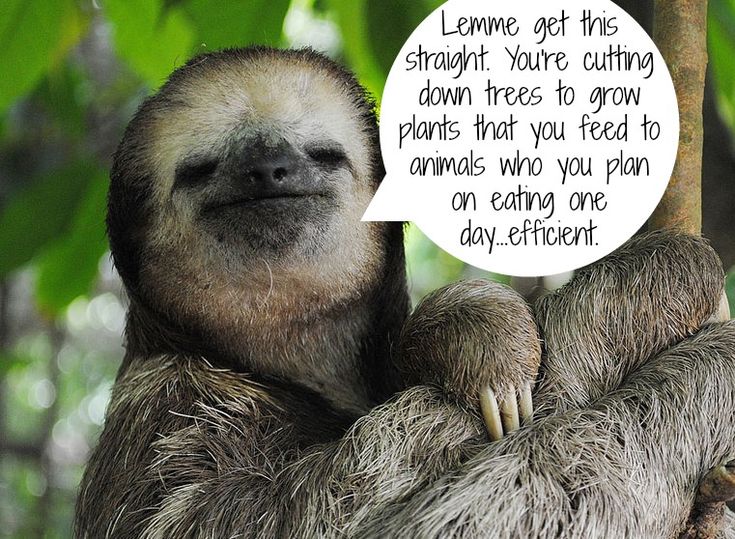 There is currently only a handful of institutions that are able to raise orphaned three-fingered sloths successfully, and unfortunately, very few of these have been considered appropriate for release back into the wild.
There is currently only a handful of institutions that are able to raise orphaned three-fingered sloths successfully, and unfortunately, very few of these have been considered appropriate for release back into the wild.
Zoos featuring sloths only display two-fingered sloths, usually Linnaeus’ two-fingered sloths (Choloepus didactylus). This is because two-fingered sloths are much more successful in captivity than three-fingered sloths, with the Bradypus species having exceptionally short lifespans in captivity.
Three-fingered sloths are very fragile and hard to keep in captivity.
Do baby sloths get used to people?
Sloths do not humanize in the same way as other mammals, and it has not been reported that orphaned sloths raised in captivity become attached to their carers. Sloths do become desensitized to the presence of humans, and current reports from rescue centers that have released captive-raised sloths have shown that these sloths are attracted to the presence of people.
It is not thought that humanized sloths seek out humans for affection, but it is more to do with seeking out what is familiar. Sloths are creatures of habit, and the inappropriate protocols for raising orphaned baby sloths within some rescue centers does not properly prepare them for life in the canopy, leading to an increased amount of human-animal conflict. When platforms and human food, such as vegetables, are provided throughout the raising process, and little preparation for life in the wild is conducted, sloths will often seek out human habitations, as that is what they know to be ‘safe’.
We like to think that the baby sloths need us and love us, but the truth is the opposite of that! /Photo Suzi Eszterhas
Sloths do not show affection towards people, and in fact, may even actively dislike people. Studies have shown that human physical contact with captive-raised sloths who are desensitized to human presence will still trigger a stress response.
It is for these reasons that rescue centers are advised to have as little physical contact with the sloths as possible, utilizing the babies’ biological need to hold onto something by transporting babies on stuffed toys to avoid any physical contact with their carers. Baby sloths will place themselves on their toys for feeding, replicating the position they would be in to suckle from their mothers.
Although they need each other, baby sloths fight a lot!
Can I have a pet baby sloth? Can I buy a baby sloth?
Owning a baby sloth is wrong for a multitude of reasons. Firstly, as mentioned above, it is very hard for even professional wildlife carers to keep baby sloths alive, and raise them for release.
Sloths are not affectionate creatures by nature, and while they may form bonds with each other as babies, this will usually disappear by adulthood. Sloths become extremely stressed when experiencing human contact – their smiling faces are deceptive, they do not show many outward signs of stress.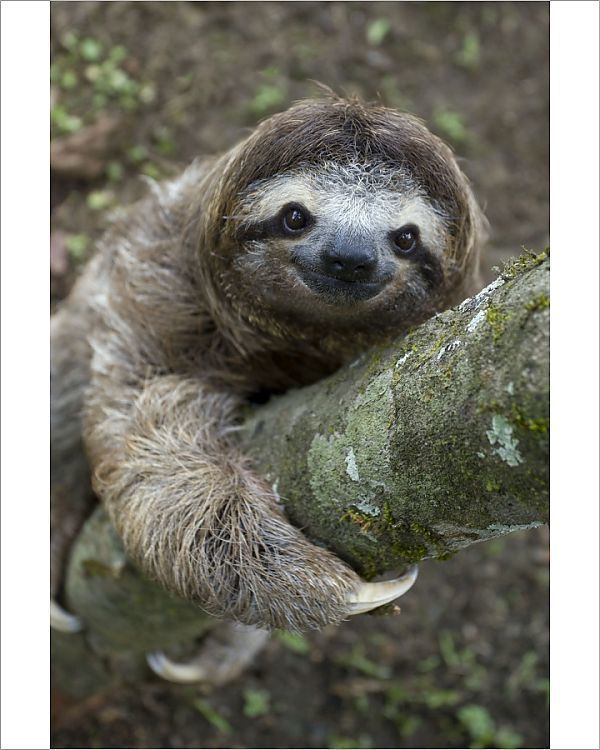 Swiping is one way that sloths exhibit stress, and even this is often misinterpreted by humans as ‘waving.’
Swiping is one way that sloths exhibit stress, and even this is often misinterpreted by humans as ‘waving.’
In this viral photo, the young sloth is showing signs of stress. The arms open means they are in defensive behavior.
Sloths can be up to three times stronger than a human being, and can cause significant injury to people if given the opportunity. Two-fingered sloths, who fair better in captivity than three-fingered sloths, also have four razor-sharp pseudo canines which will easily slice through human flesh.
These are still just baby teeth. The bite of an adult sloth is very painful and can be dangerous.
Sloth adoptions!
However, you can still symbolically adopt a sloth for you or a loved one! You can choose physical, virtual, or VIP packages! 100% of the proceeds of these adoptions go towards funding our conservation programs to protect sloths in the wild.
Looking for something else that is full of cute baby sloths? The Official Sloths Wall Calendar, with interesting sloths facts written by Dr. Rebecca Cliffe and adorable photos by wildlife photographer Suzi Eszterhas! Proceeds from the calendar also go directly towards helping sloths in the wild!
Rebecca Cliffe and adorable photos by wildlife photographer Suzi Eszterhas! Proceeds from the calendar also go directly towards helping sloths in the wild!
What Do Sloths Eat? Sloth Diet, Food, and Digestion
- Sloths are folivores
- It takes up to 30 days to digest a leaf
- Ambient temperature affects sloths’ digestion
- Sloths eat small quantities of leaves per day
- Sloths have unusual toilet habits
What is a folivore?
A folivore is an animal that specializes in eating leaves. From the Latin folium meaning “leaf” (same root word as foliage) and the suffix -vore, meaning “to eat” or “to devour”, it refers to any animal that exclusively or primarily eats leaves.
All species of sloths are folivores. The three-fingered sloth eats leaves and occasionally seed pods (like Cacao pods), while the two-fingered sloth has a more varied diet that sometimes includes both seed pods and fruit.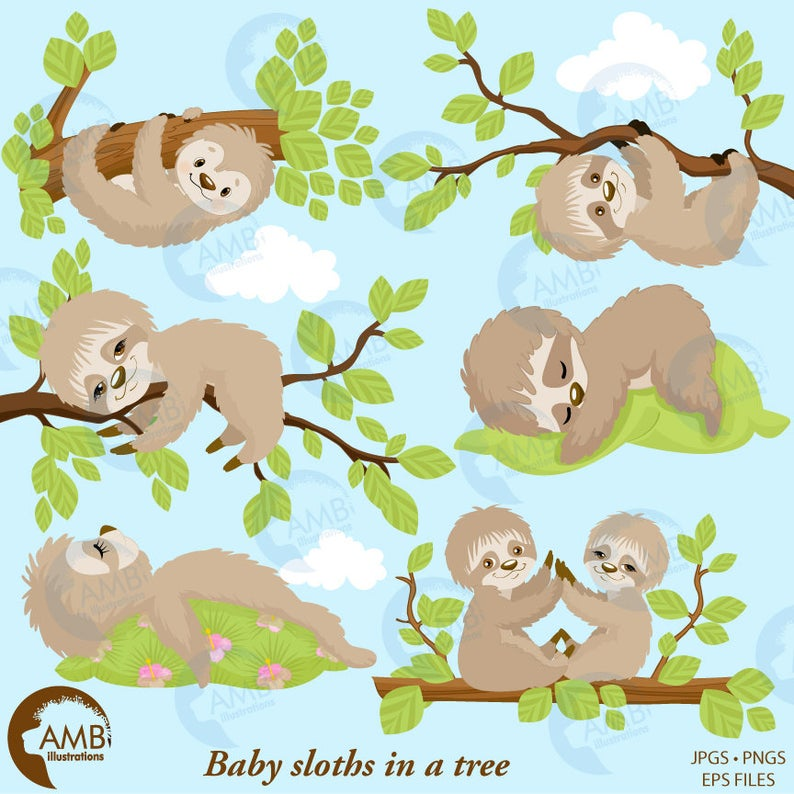
Three-fingered sloth (Bradypus variegatus) eating a cacao pod.
What kinds of trees do sloths eat?
Sloths as a species eat leaves from over 90 different kinds of trees, however, any given individual usually rotates between half a dozen to a dozen kinds of trees. They inherit these preferences from their mothers.
- Read More: Mylodon Giant Sloth, opportunistic omnivore?
Sloths are iconically associated with the Cecropia, and indeed these trees are an important part of reforestation programs that help restore sloth habitat. However, sloths need much more diversity in their habitats and diet than this. Montgomery and Sunquist (1975) listed 28 tree species and three lianas used for food by nine Brown-throated sloths (B. variegatus) and Queiroz (1995) listed 16 plant species in a study also carried out with Brown-throated sloths in the Mamirauá Reserve, in the Amazon.
Three-fingered sloths:
- Cacao pods and leaves (Theobroma cacao)
- Sangrillo (Pterocarpus officinalis)
- Cecropia spp.
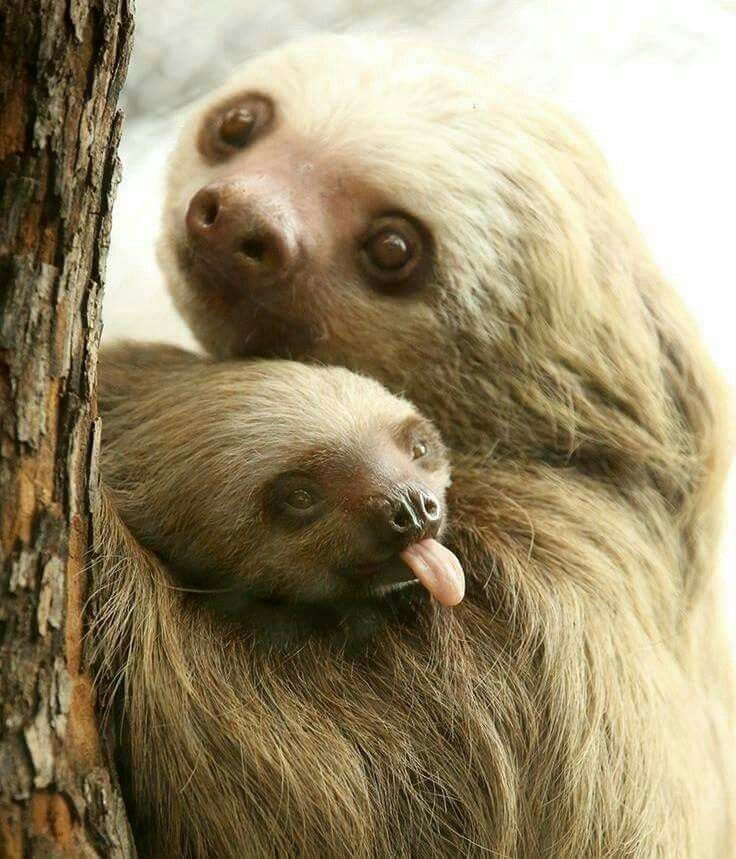
- Colorado (Luehea seemannii)
- Chilamate (Ficus insipida)
- Sapotaceans (Micropholis venulosa)
- Fig trees (Ficus spp)
- Apocynaceas (Mandevilla sp.)
- Moraceae
- Euphorbiaceae
- Bombacaceae
Two-fingered sloths:
- Bobacaceae flowers
- Barrigon leaves and flowers (Pseudobombax septenatum)
- Liana
- Espave (Anacardium excelsum)
- Poró (Cochlospermum vitifolium).
- Jobo (Spondias spp.)
- Read more: Sloths need more than Cecropia for survival
How do folivores digest food?
Trees evolved leaves to collect and process sunlight, not to be eaten, and leaves have very tough cell walls containing large amounts of cellulose. Mature leaves may also contain chemicals that build up over time and make the leaves toxic if eaten in large quantities. Leaves also contain very few calories compared to other food sources, and in order to eat enough leaves to meet their energy requirements, folivores have some unique feeding habits and specialized digestion.
To avoid toxins and tough cellulose, sloths favor fresh new leaves that typically grow on the end of branches. They move from tree to tree, eating fresh leaves from a variety of sources. This means that any toxins present in one type of leaf are unlikely to build up over time in the sloths’ bodies.
Sloths do not digest the nutrients from leaves directly. Instead, they have a very complex digestive system that enables bacteria in the sloths’ gut to ferment and break down the leaves; the sloths derive their caloric and nutrient requirements from this gut bacteria.
How does ambient temperature affect sloths’ digestion?
As with most mammals, the gut bacteria of sloths are sensitive to temperature, however, sloths are poikilotherms, meaning that compared to most mammals sloths do not maintain a constant body temperature. Instead, the ambient temperature of the surrounding rainforest determines how warm or cold a sloth is.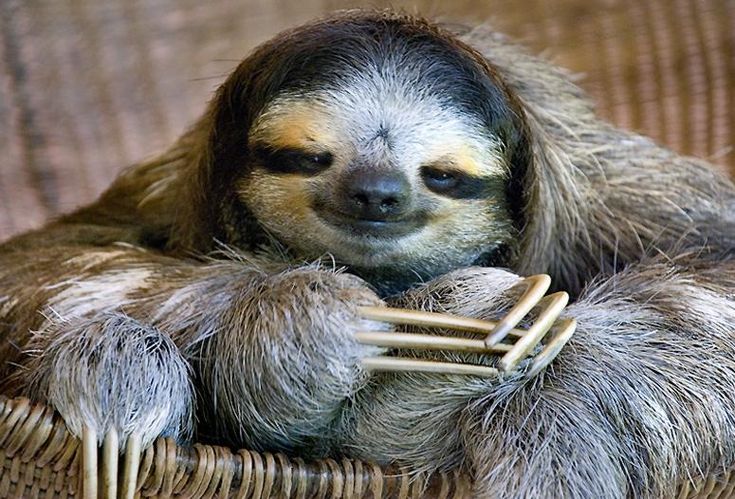 This is a very efficient evolutionary strategy to help sloths save energy and camouflage them from predators that detect infrared radiation (such as some snakes), but it makes sloths very vulnerable to extreme temperatures.
This is a very efficient evolutionary strategy to help sloths save energy and camouflage them from predators that detect infrared radiation (such as some snakes), but it makes sloths very vulnerable to extreme temperatures.
Sloths also bask under the sun / Photo by Cristhian Chentiko
If a sloth gets too cold, the bacteria in their gut can die and leave the sloth unable to digest any more food. Even if the sloth warms back up, the bacteria will have been killed off and the sloth could starve to death—even with a full stomach full of leaves. In rescue centers that specialize in rehabilitating wild sloths, emergency probiotics taken from healthy sloths can replenish this gut bacteria and save a cold sloth from starvation.
- Read More: Sloths Like It Hot: ambient temperature modulates food intake in the brown-throated sloth (Bradypus Variegatus)
How much do sloths eat?
Sloths do not eat a large quantity of food on a daily basis. The average dry weight of leaves eaten by any given three-fingered sloth is approximately 73.5 grams (2.5 ounces) per day. This is only one-third of the amount eaten by howler monkeys, which eat many of the same leaves, live in the same habitat, and are about the same size as sloths. Sloths eat slightly more on warmer days, but there is little variation in food intake between individuals, suggesting that sloths’ feeding habits are very well optimized for their environmental conditions.
The average dry weight of leaves eaten by any given three-fingered sloth is approximately 73.5 grams (2.5 ounces) per day. This is only one-third of the amount eaten by howler monkeys, which eat many of the same leaves, live in the same habitat, and are about the same size as sloths. Sloths eat slightly more on warmer days, but there is little variation in food intake between individuals, suggesting that sloths’ feeding habits are very well optimized for their environmental conditions.
Sloths drink water
A long-held presumption in ecology is that sloths get all the water they need from the foliage they consume, and few documented observations exist of either of the two sloth genera (Bradypus and Choloepus) drinking in the wild.
Male Three-fingered sloths drinking water / Photo: Suzi Eszterhas
Rainforests, in general, are becoming hotter and dryer with global warming. In addition, fragmented forests in urban areas tend to have hotter temperatures in the understory, because of more light penetrating the forest. Dr. Rebecca Cliffe believes that this is making urban sloths need to drink more and travel further to find water.
Dr. Rebecca Cliffe believes that this is making urban sloths need to drink more and travel further to find water.
- Read more: Do sloths drink water?
How do sloth moms feed their babies?
Sloths are mammals, which means that they nurse their young on milk. Baby sloths crawl onto their mother’s stomach immediately after birth and cling to her, suckling small amounts of milk throughout the day. Producing milk is energetically expensive, so sloth moms can’t store much milk–instead, they produce milk on-demand as the baby needs it.
Baby sloths learn from their mother what leaves are good to eat / Photo: Suzi Eszterhas
What do baby sloths eat?
Young sloths begin supplementing their diet with leaves as young as one week old. Baby sloths are very curious about what their mother is eating, and they will sample leaves from her mouth as she eats.
As they do this, they learn which leaves are good to eat and which to avoid, and this early exposure will stay with them throughout their lives. Teaching baby sloths which leaves to eat is a major challenge for rescue centers that seek to raise orphan sloths to return to the wild.
Teaching baby sloths which leaves to eat is a major challenge for rescue centers that seek to raise orphan sloths to return to the wild.
- Read More: Baby sloths, everything you always wanted to know
What do captive sloths eat?
Many captive sloths live in zoos far from their native tropical rainforests. This can make getting fresh, natural foliage for sloths’ diets very difficult, and so many organizations will feed sloths whatever plants are available, such as vegetables, including root vegetables and plants from non-tropical climates, which they have not evolved to eat.
The typical food plate for a two-fingered sloth in captivity consists of boiled carrots, eggs, flowers, celery, green beans, and bananas. This diet has far too much glucose for sloths and can lead to health complications including diabetes and heart disease.
It is theorized that this has a negative impact on sloths’ health and lifespans, however, this will only be confirmed once scientists can better evaluate the lifespans of wild sloths and compare them to sloths living in captivity.
How long does it take sloths to digest leaves?
Sloths digest leaves like they do everything else: slowly. A single leaf can take up to 30 days to pass through the sloth’s digestive tract. Unsurprisingly, this is the slowest digestion rate of any mammal. Humans, for example, digest their food in 24 to 72 hours (1 to 3 days) depending on what kind of food it is, and hummingbirds can complete a digestive cycle in 10 minutes.
Sloths’ digestive systems
Sloths have some very unusual anatomy, and their digestive system is no exception. Of particular note is the fact that a sloth’s esophagus has a loop in it; instead of connecting in a direct line from the mouth to the stomach (as in humans), it forms a loop like a roller coaster. This helps any swallowed food stay in the stomach while the sloth hangs upside down in the trees.
Their unusual esophagus keeps sloths’ food in their large, four-chambered stomachs no matter what. A sloth cannot vomit, belch or even fart, so it is very important that they do not eat anything bad for them or anything that produces excess gas.
A sloth cannot vomit, belch or even fart, so it is very important that they do not eat anything bad for them or anything that produces excess gas.
Image from the paper: Sloths (Bradypus variegatus) as a polygastric mammal (Ellen Y. E. Mesquita,Paola C. Soares,Luise R. Mello,Elisa C. B. Freire,Ana R. Lima,Elane G. Giese,Érika Branco)
Some amount of gas is produced from the gut bacteria as part of the digestion process; this gas is diffused into their bloodstream and carried away to be slowly expelled through the lungs or skin. Sloths’ large stomachs also act as a floatation device when the sloths must swim across rivers to reach new territory.
Image: Catriona Gibb
Are sloths geophages?
Geophagy is when animals intentionally eat earth or soil, including clay, chalk, or termite mounds. Two-fingered sloths have sometimes been known to eat dirt from the ground, which is a far cry from their usual diet of leaves from the sky! Animals may do this to aid in digestion, absorb toxins, or access nutrients not found in their usual diet. It is thought that the sloths engage in geophagy to supplement nutrients and minerals that are sometimes not available in leaves.
It is thought that the sloths engage in geophagy to supplement nutrients and minerals that are sometimes not available in leaves.
How are sloth toilet habits unusual?
Sloths are very particular about how and when they go to the bathroom. Although they live in the canopy, they travel all the way to the forest floor to poop. Wild sloths defecate approximately once per week, and they can poop out as much as 30% of their body weight when they do.
Sloths’ pooping ritual involves climbing down to the base of a tree, doing a special “poop dance” that includes wiggling their rear end back and forth, and in the case of three-fingered sloths, digging a small hole with their tail to poop in.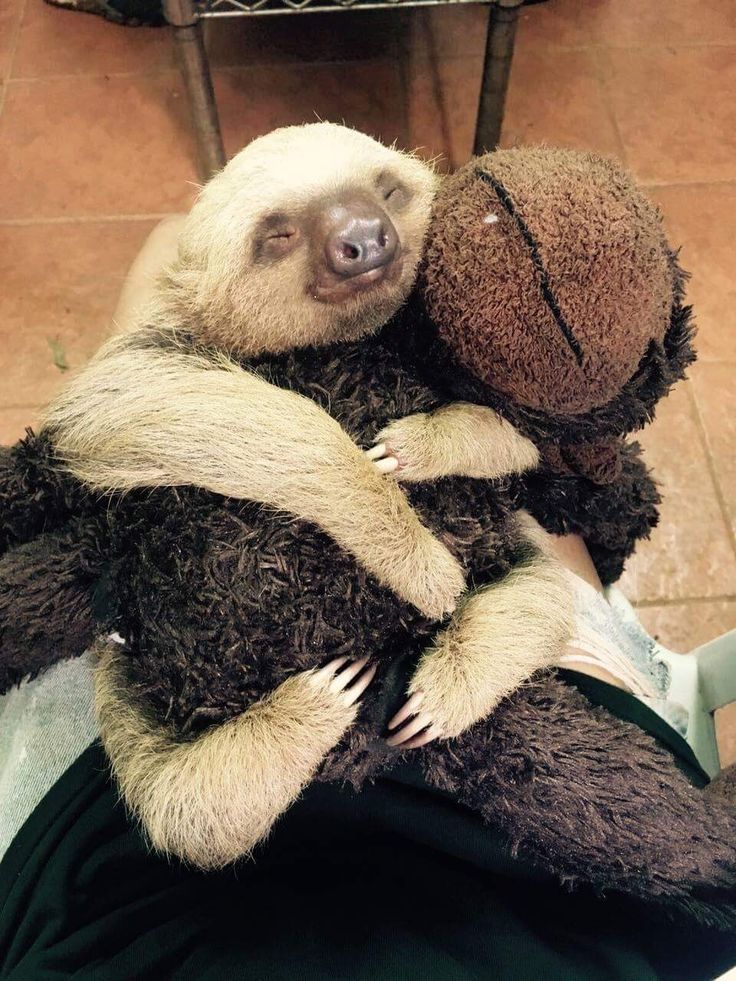 Two-fingered sloths do not have tails and skip this step. When they are finished, the sloth climbs back up the tree and resumes hanging out in the canopy. Sloth feces is rich with nutrients and makes an excellent fertilizer for the trees they inhabit.
Two-fingered sloths do not have tails and skip this step. When they are finished, the sloth climbs back up the tree and resumes hanging out in the canopy. Sloth feces is rich with nutrients and makes an excellent fertilizer for the trees they inhabit.
- Read More: Why do sloths really poop on the ground?
Do sloths eat the algae that grows on them?
Sloth fur is a miniature, mobile ecosystem that the sloths carry around with them. Fed by rainwater, algae grows on the hair, moths reproduce in sloth feces and then migrate back to a sloth to begin the life cycle over again. It was once speculated that these verdant green algae acted as a kind of garden, fertilized by moths, that the sloths would eat (from themselves and each other), supplementing their diet with nitrogen and phosphorous.
Photo: Suzi Eszterhas
While sloths groom their fur daily, they do not lick their fur like a cat would, and they are not social animals and do not engage in social grooming.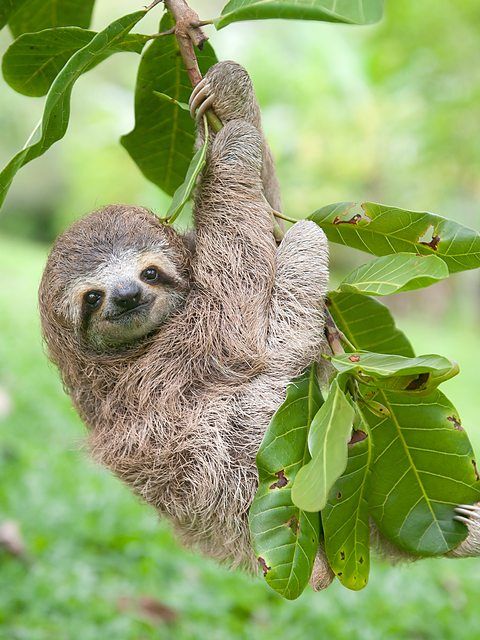 The algae grow in specialized cracks in the sloths’ fur and are not found in sloths’ digestive systems, suggesting that they do not consume it. Additionally, there is no evidence suggesting that the algae feed off of moths or their byproducts.
The algae grow in specialized cracks in the sloths’ fur and are not found in sloths’ digestive systems, suggesting that they do not consume it. Additionally, there is no evidence suggesting that the algae feed off of moths or their byproducts.
The role of sloth moths and how they benefit the sloths is not well understood, and much more research is necessary to understand the details and unique nature of the sloth fur ecosystem.
-Rebecca Cliffe
The whole truth about sloths: why they never want to run
- Stephen Dowling
- BBC Future
Image copyright Getty Images
Sloths do everything slowly, even blink. How did it happen that these animals lead such, to put it mildly, measured life? Do they never want to run?
Sloths, as their name implies, have nowhere to hurry. They spend most of their time in the trees in the forests of Central and South America, hardly moving, and descend to the ground (about once a week) only to defecate.
They spend most of their time in the trees in the forests of Central and South America, hardly moving, and descend to the ground (about once a week) only to defecate.
The life they lead goes by in slow motion. How did evolution lead them to this?
- Why it's important for us to know the whole truth about purring cats
- The whole truth about pigs: we made them that way
- The whole truth about dung beetles: they save the world
- The whole truth about chickens: they are not stupid at all
Modern sloths (three-toed and two-toed) are much smaller than those that lived on Earth in the prehistoric period. Those were truly gigantic - weighing several tons. They inhabited our planet in the last ice age and disappeared about 11 thousand years ago.
They walked on the ground, and in order to get the leaves on which they ate, they stood on their hind legs.
"The change that has taken place in sloths is the result of them starting to live in trees and feeding almost exclusively on leaves," says Camila Mazzoni from the Leibniz Institute for Wildlife Research (Germany).
Image copyright, Getty Images
Image caption,Sloths spend most of their lives in trees, away from rainforest predators
slow metabolism.
This is partly due to where they live. All six species of sloths live in tropical forests. It is hot and humid there, so there is no need for movement that warms the muscles and the cardiovascular system. That's lazy and do not strain.
There are advantages to being a mammal. The ability to regulate core body temperature makes it possible to live in a much colder climate than reptiles or other cold-blooded animals can.
But warm-blooded nature also has some disadvantages. To keep this energy-hungry system running, mammals have to eat a lot and keep their muscles warm to move around smoothly.
This endothermic adaptation allows mammals to exist in almost any habitat on Earth, including at both poles.
But here and there some mammals have given up the advantages that nature has given them. They chose an energy-saving lifestyle, more reminiscent of the lifestyle of cold-blooded animals.
"The thermoregulatory system that most mammals have requires a lot of energy," says Mazzoni. "Because sloths don't have that system, they need far less energy. However, that means they can only live in the tropics, and not high up in the mountains." where temperatures can drop. However, two-toed sloths sometimes climb higher up the mountains in Costa Rica."
Image copyright, Getty Images
Image caption,A tree-leaf diet is nutrient-poor and very low in calories
Skip the Podcast and continue reading.
Podcast
What was that?
We quickly, simply and clearly explain what happened, why it's important and what's next.
episodes
The End of the Story Podcast
The fact that sloths spend most of their lives in trees greatly reduces their risk of being preyed upon by a predator such as a jaguar.
This is another reason why they do not need the ability to quickly respond to danger - and huge amounts of energy to maintain this ability.
"They have a special relationship with trees," says Mazzoni. "The sloths depend on them."
She says that sloths often climb up to the top of the tree in the morning to expose their bodies to the rays of the sun, and when it gets too hot they go back into the shade. Behavior more typical of cold-blooded lizards and other reptiles than mammals.
Becky Cliff, a British zoologist at the Costa Rican Sloth Conservation Trust, says you have to see sloths in their natural habitat to understand how slow they are.
"Everyone knows that they move slowly. But when you look at them, you understand what it is - how slowly they turn their heads, how slowly they blink. They do literally everything slowly. Therefore, it takes a lot of time to observe them" .
But when you look at them, you understand what it is - how slowly they turn their heads, how slowly they blink. They do literally everything slowly. Therefore, it takes a lot of time to observe them" .
If you look closely, you can see a green tint in the sloth's coat. It is tempting to conclude that these animals lead such an immobile lifestyle that they are overgrown with moss. But, as Mazzoni says, we risk missing out on something completely amazing.
"Their coat has changed so much that it has some kind of pores in it, in which mushrooms and algae grow (the climate is very humid)," she says. "And this is not because they are slow. It is a kind of symbiosis ]".
Why do sloths need algae? Many scientists are looking for the answer to this question. "Perhaps they are needed for camouflage," Mazzoni suggests.
Green algae and fungus on wool can help sloths merge with tree crowns, dissolve in them.
"It could also be an additional source of protein," says Mazzoni, noting that sloths sometimes lick what has grown on their fur.
Mushrooms can also help fight parasites. "The fur of sloths is almost completely water-repellent and keeps out many types of parasites. Sloths have fewer parasites than any other mammal of similar size."
Image copyright, Getty Images
Image caption,Baby sloths can suckle their mother's milk because the mother produces very little milk
And here's another way sloths differ from other mammals - the amount of milk when feeding offspring.
"Mothers don't have large stores of milk, it just oozes drop after drop," says Cliff. Baby sloths cling to their mother's fur near the nipples and wait for milk to come out.
Cliff has been watching sloths in the Costa Rican jungle for many years and knows a lot about their behavior.
"They don't jump or run. But they have incredibly strong front legs. If a sloth and a human could compete in arm wrestling, arm wrestling, then the sloth would win for sure. "
"
But the sloth's hind legs don't have the same muscle mass, because they don't need it.
The sloth approach to life should not be confused with laziness, Cliff emphasizes. "They are not lazy. Howler monkeys living in the forests sleep up to 18 hours a day, and sloths only about 10."
If sloths did not live in the hot and humid climate of the rainforest, they would probably be faster and more cheerful. But countless generations of these animals grew up in just such conditions. As a result, the ideal pace of life has developed.
"They're showing us that we don't have to run all the time looking for food," says Cliff. "It's soothing."
--
You can read the original English version of this article at BBC Future.
A sloth from the Moscow Zoo became Dimax's friend :)
A couple of months ago we thought that we were succeeding in life: the company is developing, a new line of mattresses is being prepared for release (but this is a secret), turnover is growing. And also think about those who are not so smooth. Our development manager Denis Basov insisted that we start sharing our happiness with others. And we decided to start with the Moscow zoo, from which a couple of months ago Denis brought another portion of pleasant impressions.
And also think about those who are not so smooth. Our development manager Denis Basov insisted that we start sharing our happiness with others. And we decided to start with the Moscow zoo, from which a couple of months ago Denis brought another portion of pleasant impressions.
We thought for a long time about which animal could become our friend, offered different options, and suddenly realized that the only representative of the zoo who can truly appreciate our work is a sloth. After all, these animals are one of the leaders in their love for peace and comfort, spending 10-15 hours in a dream, and the rest of the time ... also continuing to stay in place. Our clients also like to lie on comfortable mattresses, but not because they are lazy - our clients are just very hardworking people and comfort is extremely important to them.
We called the zoo management and a few days later we were rushing there with packages of treats for the animals. We started our personal acquaintance with the guardianship department, where its coordinator Natalia Yuryevna told us about the peculiarities of friendship with the animals of the Moscow Zoo.![]() The contract was also signed there. Everything took place at home, casual style, a small, cozy office, a kind representative of the zoo, a joyful commercial director Dimaks Maxim Sperkach.
The contract was also signed there. Everything took place at home, casual style, a small, cozy office, a kind representative of the zoo, a joyful commercial director Dimaks Maxim Sperkach.
Then we went to a meeting with the senior keeper for the care of especially dangerous animals Elizaveta Kuzmicheva. Elizabeth greeted us cordially, escorted us, probably, to the holy of holies of the zoo - to the kitchen.
There we had a master class on preparing food for animals, cut from tasty treats we brought. It was conducted for us by Marina Soboleva, a highly qualified worker in the care of life-threatening animals (sounds ominous!).
As it turned out, sloths, in the wild, feeding on the leaves of different types of trees, young shoots, flowers, fruits, have a completely different diet in the zoo. It includes pumpkin, cucumbers, tomatoes and zucchini brought by us. For sloths, these vegetables are not only healthy, but also treats.
I don't know why the zoologists liked us so much (although, of course, we are cool guys!), but we were allowed to feed the sloths personally. Oh yeah, we haven't specified yet? There are three sloths in the Moscow zoo: the male Oliver, whom zoologists call Kolya in the native language, and two females, Ella and Freddie. By the way, the latter is named after the hero of the A Nightmare on Elm Street film series, Freddy Krueger. This name was given to the sloth by the previous zoologist who looked after her. The name, of course, is not the most prepossessing, but Freddie’s charm is not to be occupied - it was with them that she “bought” us and identified herself as our new friend.
Oh yeah, we haven't specified yet? There are three sloths in the Moscow zoo: the male Oliver, whom zoologists call Kolya in the native language, and two females, Ella and Freddie. By the way, the latter is named after the hero of the A Nightmare on Elm Street film series, Freddy Krueger. This name was given to the sloth by the previous zoologist who looked after her. The name, of course, is not the most prepossessing, but Freddie’s charm is not to be occupied - it was with them that she “bought” us and identified herself as our new friend.
And now we are already in the enclosure, where we only have time to dodge zebra and Japanese finches flying around, bounce off armadillos attacking our boots and maintain composure when an iguana unexpectedly appears, climbing branches like monkeys.
Sloths eat offered delicacies slowly. Their eyesight and hearing are not very good, but their sense of smell is several orders of magnitude higher due to this. Sloths first sniff the food, then, if it has passed the small control (it’s like face control, only by smell), then they grab it with their teeth and, helping themselves with their paw, chew slowly. I would like to immediately give them a second piece, but you have to wait - they deal with the first one, well, sooooo slowly :) It saves that there are three sloths, and while one meditates with a piece of yummy in his mouth, you can feed the rest.
I would like to immediately give them a second piece, but you have to wait - they deal with the first one, well, sooooo slowly :) It saves that there are three sloths, and while one meditates with a piece of yummy in his mouth, you can feed the rest.
Maxim is full of impressions from interacting with sloths: “It's a unique experience to feed the sloths! I used to think that these animals were smaller in size, but they turned out to be very large. And it's a great atmosphere! The sensations, of course, are completely different than when viewed through glass. After such meetings with animals, you understand how pleasant it is to help our smaller brothers. And I'm very glad that we took custody of the sloth! The zoo team is amazing! Marina (Keeper of the Department of Especially Dangerous Animals - ed. note) told us in great detail about the life of sloths, we were even allowed to personally feed the animals! Now we will visit the Moscow zoo much more often and go not only to Freddie, but also to other animals.











